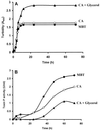Proline-rich peptide from the coral pathogen Vibrio shiloi that inhibits photosynthesis of Zooxanthellae
- PMID: 11282602
- PMCID: PMC92766
- DOI: 10.1128/AEM.67.4.1536-1541.2001
Proline-rich peptide from the coral pathogen Vibrio shiloi that inhibits photosynthesis of Zooxanthellae
Abstract
The coral-bleaching bacterium Vibrio shiloi biosynthesizes and secretes an extracellular peptide, referred to as toxin P, which inhibits photosynthesis of coral symbiotic algae (zooxanthellae). Toxin P was produced during the stationary phase when the bacterium was grown on peptone or Casamino Acids media at 29 degrees C. Glycerol inhibited the production of toxin P. Toxin P was purified to homogeneity, yielding the following 12-residue peptide: PYPVYAPPPVVP (molecular weight, 1,295.54). The structure of toxin P was confirmed by chemical synthesis. In the presence of 12.5 mM NH(4)Cl, pure natural or synthetic toxin P (10 microM) caused a 64% decrease in the photosynthetic quantum yield of zooxanthellae within 5 min. The inhibition was proportional to the toxin P concentration. Toxin P bound avidly to zooxanthellae, such that subsequent addition of NH(4)Cl resulted in rapid inhibition of photosynthesis. When zooxanthellae were incubated in the presence of NH(4)Cl and toxin P, there was a rapid decrease in the pH (pH 7.8 to 7.2) of the bulk liquid, suggesting that toxin P facilitates transport of NH(3) into the cell. It is known that uptake of NH(3) into cells can destroy the pH gradient and block photosynthesis. This mode of action of toxin P can help explain the mechanism of coral bleaching by V. shiloi.
Figures






References
-
- Ben-Haim Y, Banin E, Kushmaro A, Loya Y, Rosenberg E. Inhibition of photosynthesis and bleaching of zooxanthellae by the coral pathogen Vibrio shiloi. Environ Microbiol. 1999;1:223–229. - PubMed
-
- Brown B C. Proceedings of the 8th International Coral Reef Symposium. Vol. 1. Balboa, Panama: Smithsonian Tropical Research Institute; 1997. Coral bleaching: causes and consequences; pp. 65–74.
Publication types
MeSH terms
Substances
Grants and funding
LinkOut - more resources
Full Text Sources

